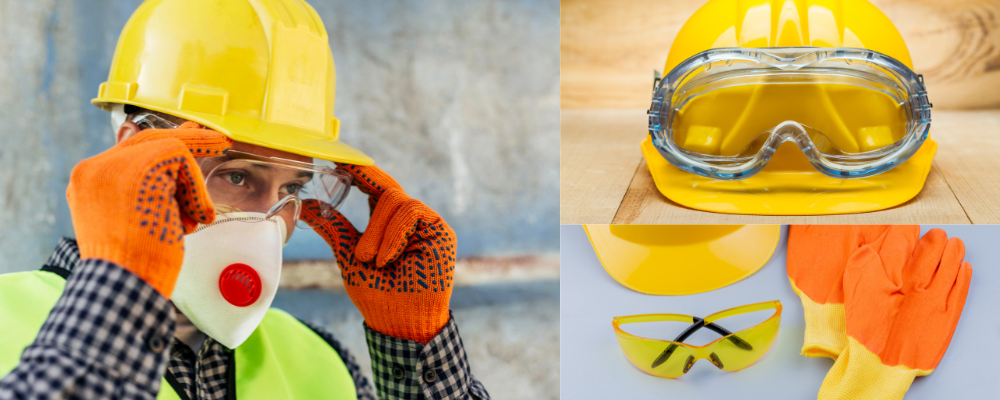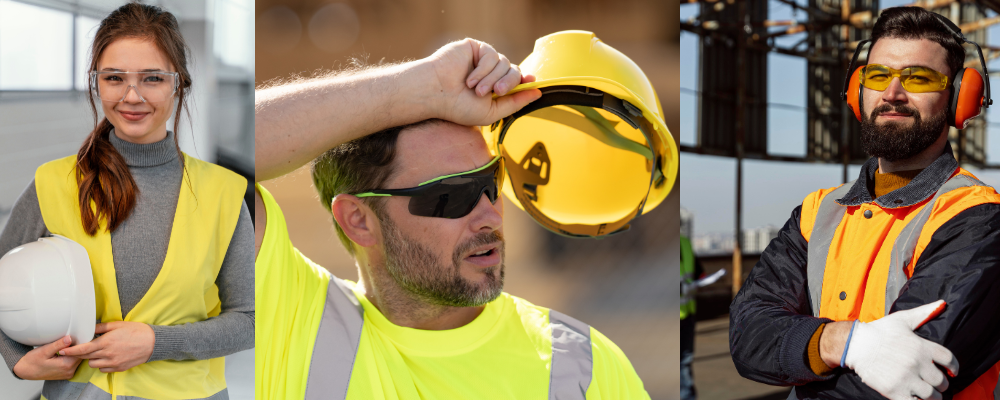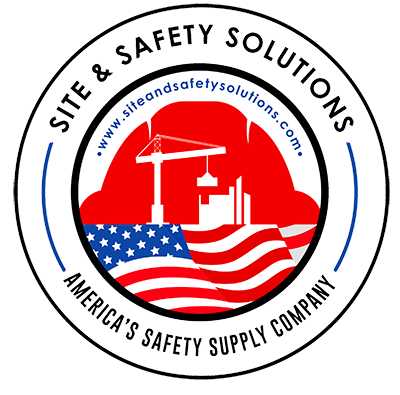
Introduction
In the construction industry, safety is paramount. One critical aspect often overlooked is eye protection. This blog aims to illuminate the significance of eye protection and the diverse range of products available to safeguard the eyes of construction workers. Construction work is a demanding and high-risk profession that demands an unwavering commitment to safety. In this blog, we’ll delve into safeguarding your sight, shedding light on the importance of eye protection for construction workers. At Site and Safety Solutions, we understand the unique challenges construction professionals face, and we offer a range of high-quality eye protection products designed to meet their specific needs.
Hazards Faced by Construction Workers
Construction sites are rife with potential threats to eye safety, including flying debris, chemicals, UV exposure, and more. Understanding these risks is pivotal to emphasizing the necessity of eye protection.
Impact of Eye Injuries
Construction sites pose significant risks to workers’ eyes due to hazards like flying debris, chemicals, intense light, etc. Understanding the consequences of these injuries emphasizes the critical need for reliable eye protection.
-
Temporary Impairment:
Even seemingly minor eye injuries can lead to significant temporary impairments. Dust particles, small debris, or chemical splashes can cause irritation, redness, and blurred vision, hindering a worker’s ability to perform tasks effectively. Temporary impairments often result in downtime, impacting productivity and workflow.
-
Reduced Productivity:
Eye injuries can lead to decreased productivity due to the discomfort and distraction caused. When a worker’s vision is compromised, they may struggle to focus, leading to slower work pace and potential errors. This not only affects individual productivity but can also impact the overall efficiency of the construction site.
-
Risk of Infection:
Injuries to the eye, even seemingly minor ones, can increase the risk of infection. Dust, dirt, or foreign objects entering the eye can create an environment conducive to bacterial growth, leading to infections that can further impair vision and necessitate medical intervention.
-
Long-term or Permanent Vision Loss:
Long-term or permanent vision loss is the most severe consequence of inadequate eye protection. Severe injuries caused by high-velocity debris, chemical burns, or intense light exposure can result in irreversible damage to the eyes, leading to partial or complete blindness. Vision loss not only affects a worker’s ability to perform their job but also impacts their quality of life.
-
Emotional and Financial Impact:
Eye injuries don’t just affect physical health; they also carry emotional and financial burdens. The trauma of losing or impairing vision can be psychologically distressing for the worker and their families. Moreover, the costs associated with medical treatment, rehabilitation, and potential loss of income can be substantial.
Eye Protection Products
Overview of Essential Eye Protection Gear
- CORE SAFETY GLASSES
- Tear-Off Safety Glasses
- 3030 | Bradford Eyewear
- Secondary Single-Bottle Eyewash Wall Station – 32 oz Capacity
- Tech Look Plus Clearfoam gasket – Work Glasses
Choosing the Right Protection
Factors to Consider When Selecting Eye Protection
- ANSI Ratings:
- American National Standards Institute (ANSI) ratings indicate the level of impact resistance and optical quality of safety eyewear. Look for eyewear labeled ANSI Z87.1 or higher, ensuring it meets or exceeds safety standards.
- Lens Tint:
- Consider the nature of the construction work. Clear lenses might be suitable for indoor work, while tinted or polarized lenses could be necessary for outdoor tasks to reduce glare and UV exposure.
- Fit:
- Proper fit is crucial for adequate eye protection. Eyewear should snugly cover the eyes without obstructing vision or causing discomfort. Adjustable frames and nose pieces contribute to a customized fit.
- Comfort:
- Comfortable eyewear encourages consistent usage. Features like padded nose bridges, adjustable temples, and lightweight materials enhance comfort during prolonged wear.

Proper Usage and Maintenance
Best Practices for Using and Maintaining Eye Protection
- Correct Wearing:
- Emphasize the importance of wearing eye protection at all times during work hours. Ensure that eyewear fits appropriately and securely to provide optimal safety.
- Cleaning:
- Instruct workers to clean safety glasses regularly using mild soap and water or specialized lens cleaning solutions. Avoid abrasive cleaners that could damage lenses.
- Storage:
- Proper storage prevents damage and maintains the integrity of eye protection gear. Encourage workers to store eyewear in designated cases or pouches to protect against scratches and impacts when not in use.
- Replacement:
- Educate workers about the lifespan of safety eyewear. Scratched, damaged, or worn-out eyewear should be replaced promptly to maintain effective protection.
Compliance and Regulations
Regulatory Standards for Eye Protection in Construction
- OSHA Standards:
- The Occupational Safety and Health Administration (OSHA) mandates safety standards for eye protection in construction. Highlight the specific OSHA regulations (e.g., 29 CFR 1926.102) that require employers to provide suitable eye protection for workers.
- Impact of Non-compliance:
- Discuss the potential consequences of non-compliance with safety regulations, including fines, injuries, and compromised vision.
- Employer Responsibilities:
- Outline the responsibilities of employers in providing and ensuring proper eye protection, including training, maintenance, and enforcement of safety protocols.
- Worker Responsibilities:
- Highlight the responsibility of workers to comply with safety guidelines, wear provided eye protection, and report any issues or deficiencies in equipment to their supervisors.
By covering these detailed notes, your blog will comprehensively inform construction workers about crucial factors in selecting, using, maintaining eye protection, and adhering to regulatory standards for ensuring safety on construction sites.
Navigating Eye Hazards in Construction: Identifying and Mitigating Risks
Construction sites are riddled with potential threats to eye safety, making workers need to understand and address these hazards effectively. This comprehensive guide aims to dissect the daily dangers construction workers encounter and provide actionable steps to mitigate these risks through informed precautions and suitable protective equipment.
Identifying Common Eye Hazards
-
Flying Debris
Construction sites are bustling environments where debris, including wood splinters, metal shards, and concrete particles, is often airborne. These pose immediate threats to workers’ eyes, leading to injuries if adequate protection is not in place.
-
Chemical Exposure
Many construction tasks involve handling various chemicals and solvents, each presenting its ocular risks. If not correctly managed, splashes or fumes from these substances can cause severe eye irritation, burns, or long-term damage.
-
Dust and Particulates
Dust accumulation from cutting, drilling, or sanding can lead to eye irritation, infections, or even abrasions if particles enter the eyes.
-
UV Exposure
Outdoor construction exposes workers to harmful UV rays, which, if prolonged, can contribute to conditions like photokeratitis (sunburn of the eye) or increase the risk of cataracts.
Mitigating Risks and Protective Measures
-
Recognition and Prevention
Workers need to recognize potential hazards and adopt preventive measures. This includes maintaining awareness of their surroundings, identifying high-risk tasks, and understanding the appropriate precautions before starting any work.
-
Use of Appropriate Protective Gear
Proper eye protection is paramount. Discuss the importance of using safety glasses, goggles, or face shields that meet relevant safety standards (such as ANSI) for specific tasks. Detail the features and functionalities of these gears in addressing different hazards.
-
Training and Education
Employers should conduct regular training sessions to educate workers on the risks and correct protective equipment usage. Emphasize the significance of a culture prioritizing safety and adherence to established safety protocols.
Understanding and addressing eye hazards in the construction industry are crucial steps toward ensuring the safety and well-being of workers. By identifying these risks, employing proactive measures, and utilizing appropriate protective gear, construction workers can significantly reduce the likelihood of eye injuries and maintain a safer work environment.

Innovations in Eye Protection Technology: Advancements for Safer Construction Sites
In recent years, technological innovations have revolutionized the realm of eye protection gear, mainly catering to the unique needs of the construction industry. This note aims to delve into the latest advancements in eye protection technology, showcasing cutting-edge products designed to elevate safety standards and comfort for construction workers.
-
Impact-Resistant Goggles:
One notable innovation is impact-resistant goggles that withstand high-velocity projectiles and blunt force. These goggles, often constructed from durable materials like polycarbonate, provide unparalleled protection against flying debris, protecting the eyes from potential hazards on construction sites.
-
Anti-Fog Lenses:
Addressing a longstanding issue, introducing anti-fog lenses has significantly enhanced visibility for workers. These lenses utilize advanced coatings or ventilation systems to prevent fogging, ensuring clear vision even in environments with varying temperatures or humidity levels, thereby reducing accidents caused by impaired vision.
-
Smart Eyewear:
Integrating intelligent technology into eyewear has marked a transformative leap in eye protection. Smart eyewear often includes features like heads-up displays, augmented reality overlays, or sensors that monitor environmental factors. This innovation offers protection and provides real-time data and guidance, enhancing worker efficiency and safety.
-
Ergonomic Designs:
Comfort is as crucial as protection when it comes to eye gear. Recent advancements have focused on ergonomic designs, prioritizing safety and wearer comfort. Adjustable fits, lightweight materials, and customizable features aim to reduce strain during extended wear, encouraging consistent usage and ensuring prolonged protection for workers.
-
Benefits and Impact:
Introducing these innovations holds immense promise in reducing eye injuries at construction sites. By providing enhanced protection, improved visibility, and user-friendly designs, these advancements contribute to a safer work environment. Reduced eye injury incidents safeguard worker well-being productivity, and minimize downtime.
The evolution of eye protection technology continues to push the boundaries of safety standards in the construction industry. These innovations mitigate risks and empower workers with tools that optimize performance while ensuring their well-being. Embracing these advancements paves the way for safer and more efficient construction sites.
Creating a Safety Culture: Promoting Eye Protection Awareness in Construction Teams
In the dynamic and hazard-laden construction world, ensuring worker safety is paramount. Fostering a culture of safety consciousness, especially concerning eye protection, is pivotal to mitigating risks and preventing avoidable injuries among construction teams.
Importance of Safety Culture:
Construction sites are inherently tricky environments, often brimming with potential hazards that seriously harm workers’ eyesight. Establishing a safety culture specifically tailored to eye protection is essential in safeguarding the well-being of personnel and minimizing accidents.
Strategies for Employers:
- Comprehensive Training Programs:
Implementing regular and comprehensive training sessions focused on eye safety is fundamental. These sessions should include identifying risks, proper usage of protective gear, and emergency procedures in case of eye-related incidents.
- Clear Safety Protocols and Guidelines:
Develop and enforce robust safety protocols explicitly addressing eye protection. Delineate the required eye gear for various tasks, specify high-risk areas, and outline step-by-step procedures for handling and maintaining protective equipment.
- Incentivizing Compliance:
Encourage adherence to safety guidelines by introducing incentives or recognition programs for workers prioritizing eye protection. Recognition can significantly motivate individuals to adopt safe practices.
- Provision of Quality Protective Gear:
Ensure easy accessibility to high-quality eye protection gear suited for diverse job requirements. Providing comfortable and ANSI-rated eyewear that meets industry standards is crucial for encouraging consistent usage.
- Cultivating Personal Responsibility:
Instill a sense of personal responsibility among workers regarding their safety. Encourage active participation in safety measures, empowering them to speak up about unsafe conditions and take proactive steps to protect themselves and their peers.
Cultivating a Mindset of Safety:
Creating a safety-conscious mindset within construction teams involves a holistic approach integrating education, reinforcement, and empowerment. Continual support of safety practices, open communication channels for reporting hazards, and periodic reviews of safety protocols are instrumental in fostering a culture where safety is not just a rule but a way of life.
For more information, visit our website and Facebook page.
For more products, visit our website :
Secondary Single-Bottle Eyewash Wall Station – 32 oz Capacity
Tech Look Plus Clearfoam gasket – Work Glasses
Conclusion:
Reiterate the vital role of eye protection in safeguarding the well-being of construction workers. Encourage a proactive approach towards safety and the utilization of appropriate eye protection gear. Promoting eye protection awareness within construction teams is not merely a regulatory obligation but a moral imperative. Employers who invest in cultivating a safety culture around eye protection reap the benefits of reduced accidents, increased productivity, and, most importantly, the well-being of their workforce. It’s a collective responsibility to ensure that every worker returns home safely at the end of the day. Safeguarding your sight is non-negotiable in the construction industry. With our range of eye protection products at Site and Safety Solutions,









